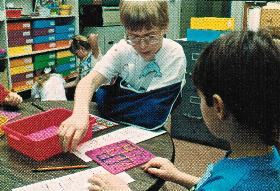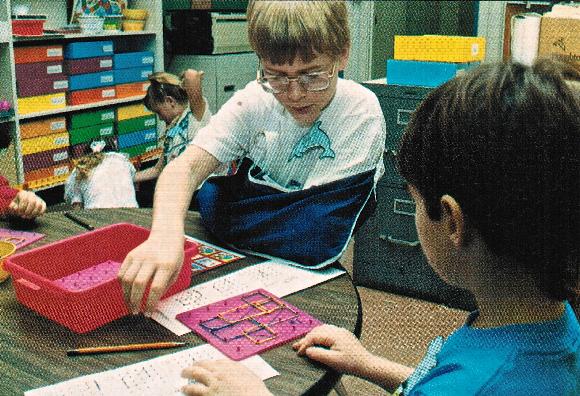
also knows that six times four equals four times six equals twenty-four because 4+4+4+4+4+4 = 24 and 6+6+6+6 = 24, or as Nicole put it, “four, eight, twelve, sixteen, twenty, twenty-four!”
“Incidentally,” Shoecraft volunteered, “I let them count on their fingers.” As he said that, I felt my hands automatically go rigid at my side. “Oh?” I grunted suspiciously. Sensing my discomfort, he asked, “Is that a problem for you?” I said, “Well, it’s not the way I learned math.” Patiently, Shoecraft explained, “You have to ask yourself, what are children trying to do when they use their fingers?” Tentatively I offered, “Trying to figure the answer out?” Smiling at me, he asked, “Do you really have a problem with that?” Looking around that happy classroom, I found I didn’t anymore.
As at the University of Chicago [and its School Mathematics Project, resulting in the textbook series, Everyday Math], algebra and geometry are integral to POC’s elementary school curriculum. Here, students determine the area of irregularly shaped geometric figures using “geoboards” and elastic bands. Algebra is introduced first through the balance beam as a means of establishing the equality of different equations. Students also learn to graph coordinates (in seasonal patterns of pumpkins and ghosts) and construct verticle and horizontal bar graphs.
Shoecraft’s program works—and it works for kids from a variety of socioeconomic backgrounds. Both Port O’Connor and neighboring Wharton Independent School District have completely eliminated ability grouping and tracking through Shoecraft’s program. The Wharton student population is a mix of Hispanics (30 percent), blacks (30 percent), and whites. The crucial ingredient in the success of MOVE IT Mathematics is the total Commitment to the philosophy that, given a multiplicity of learning approaches, every kid can learn math. If one way doesn’t work, then another one is tried.
Toward a New Learning …
A major goal of Paul Shoecraft is to demonstrate to students that mathematics is fun, and to teachers, that memorization is not the most effective methodology….
In many ways, the school reform experience in mathematics is a metaphor of the whole school reform-restructuring agenda—and it is instructive to look at it that way. For example, the principle that all kids can learn, that curricular content ought to be developed and presented from the base of students’ previous knowledge and experience, and that classrooms structured as laboratories and workshops work better are clearly not unique to the study of mathematics.…
From the host of other reform programs in mathematics there is much to be learned if we are to move from the xxx
present stage of small-scale, programmatic change to large-scale, systemic change. First, reform programs are invariably attached to an individual teacher or two, not to the school. In spite of the multitude of such programs, very few ever become integral parts of the overall school curriculum. The reasons for this failure are many, however several should be flagged. Teacher burnout is high in special programs; there is seldom paid time for program development; external program funding runs out; and there is rarely any program followup or networking among teachers in isolated programs.
Second, there is a good deal of anecdotal evidence that learning-disabled students perform exceptionally well in the new learning environments. One suspects that research will validate this result and that the reason for students’ success lies in the multiplicity of conceptual presentations. Third, there is anectotal evidence that self-confidence and self-esteem accrue to students who achieve in mathematics and that this accounts for higher student achievement across the board. This result may well be rooted in the belief that mathematics is “hard” and that if students learn this most difficult subject, they begin to believe they can learn anything. Finally, it must be observed that the reconstruction and restructuring of the school mathematics curriculum is among the most important problems in education reform. Without mathematics reform, there can be no science reform—without science reform, no real education reform. (Italics added.)
But in this, we are furtunate, because, far from being the intractable problem it often seems, we know a great deal about “the trouble in mathematics” and what can be done to fix it.… All kids can learn math, and it’s time they begin to do so. (Italics added.)
Next > | New Math Formula | Kindermath | Demonstration | Federal Funding | Inservice Funded | Anyone Can Learn Math | Summer Volunteers | Monster Math | Making Math Fun | Area Leaders | New Math of 90s | Video | MOVE IT! | Math Made Easy | VIPS to View Pgm | Gov. Richards | Richard's Attention | Revolution | Adds Up | Mexico | Letter | Atlanta 2003 | < Back — HOME

